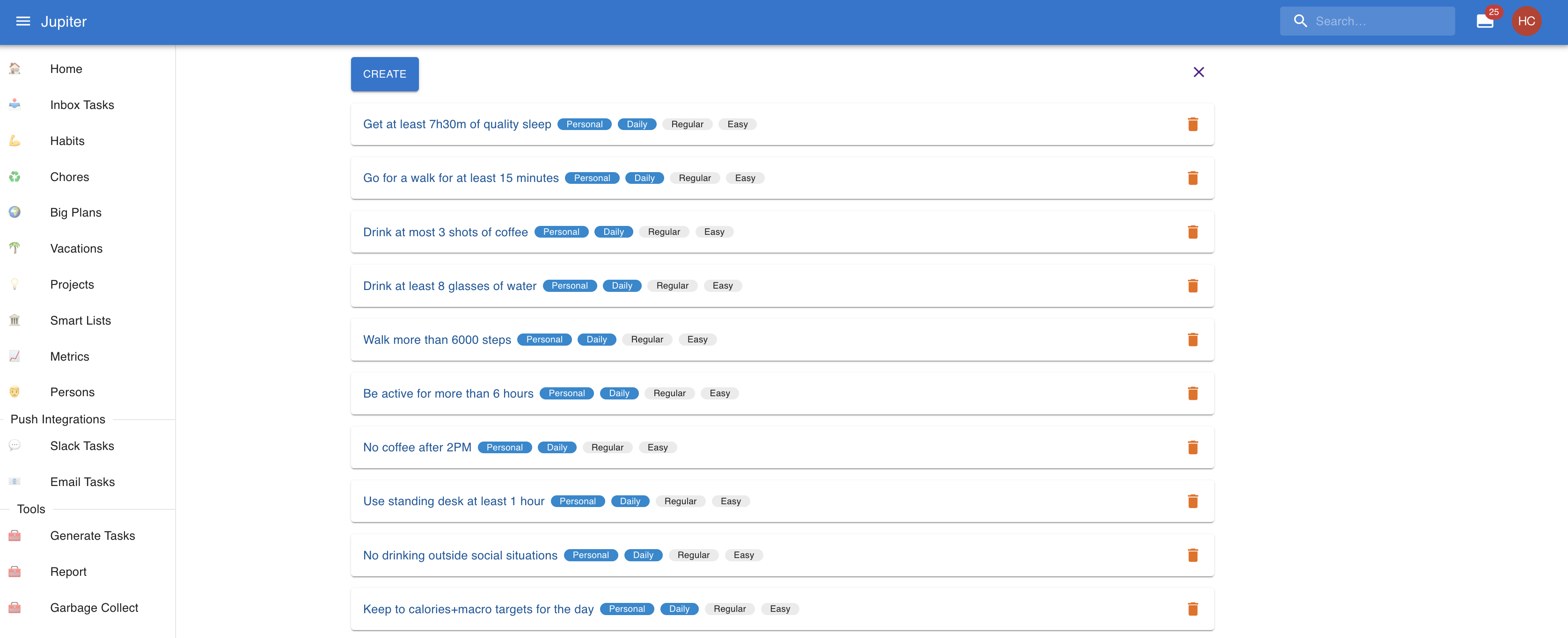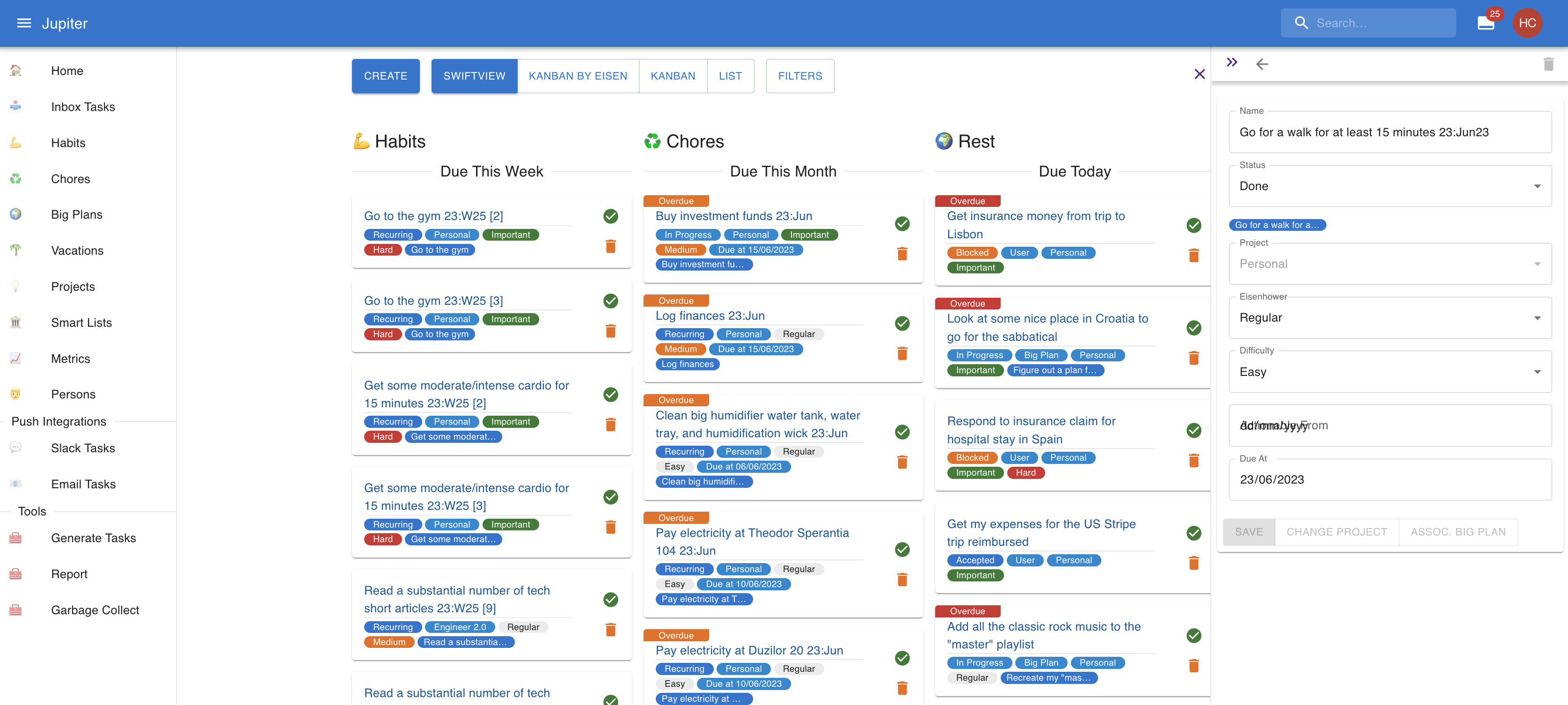Habits
A habit is a regular activity, usually one that is centered on you. Habits live in the"habits" view, but they're instantiated as regular tasks in the "inbox".
For example, you can have a habit like "Walk more than 10000 steps every day" or"Meditate for 5 minutes".
In the habits view, the task templates might look like this:

Properties
Habits have a period and a period interval. The former is set via the
periodproperty and the latter is derived uniquely from this. The period can be
one of:
- Daily: a task which needs to happen once a day. In a year there will be 365 or 366 instances of such a task, and the period interval for each one will be each day. The intervals are numbered from 1 to 365.
- Weekly: a task which needs to happen once a week. In a year there will be 52 instances of such a task, and the period interval for each one will be the corresponding week. The intervals are numbered from 1 to 52.
- Monthly: a task which needs to happen once a month. In a year there will be 12 instances of such a task, and the period interval for each one will be the corresponding month. The intervals are numbered from 1 to 12.
- Quarterly: a task which needs to happen once a quarter (group of three months). In a year there will be 4 instances of such a task, and the period interval for each one will be a group of three consecutive months (Jan/Feb/Mar, Apr/May/Jun, Jul/Aug/Sep, and Oct/Nov/Dec). The intervals are numbered from 1 to 4.
- Yearly: a task which needs to happen once a year. In a year there will be 1 instance of such a task, and the period interval for it will be the full year. The intervals are numbered by the year.
Notice that the smallest period is the daily one, with a period interval of
one day. Ingeneral, for a given period interval there can be only one
instantiation of a task of thatperiod.
While in the inbox, the instantiated tasks might look like this:}

The instantiated task in the inbox is constructed from the habit template, butit also changes in the following way:
- The name contains the period interval for which the task is active. So "Meditate for 5 minutes" becomes "Meditate for 5 minutes Feb23". The formats are "Feb22" for daily periods, "W13" for weekly periods, "Mar" for monthly periods, "Q1" for quarterly periods, and "2020" for yearly periods.
- There is a link back to the owning habit.
- Most fields are not editable.
Habits can be marked as key habits. This is first a user-level concept - it marksthe habit as an important one for you, that is absolutely necessary to get right. Invarious other contexts it applies, helping with sorting, prioritization, etc.
Habits can also have an actionable date. By default there is none, and the
generatedinbox task won't have an actionable date. If you specify an
actionable_from_day and/oractionable_from_month properties, they will
determine the inbox tasks to have one. They work likeso:
- For tasks with weekly and monthly periods, the
actionable_from_dayproperty can be set. This will set the actionable date to be that many days into the period interval. - For tasks with quarterly and yearly periods, the
actionable_from_monthandactionable_from_dayproperties can be set. The first parameter will specify the month in the period interval to set the actionable date to. Ifactionable_from_dayis not set, the first day of the month is used, otherwise the specified day is used.
Habits also have a deadline. By default the deadline is the end day of the
periodinterval, at midnight. You can override it however to specify, via the
due_at_day anddue_at_time properties. They work like so:
- For tasks with daily period, only the
due_at_timeproperty can be set. For exampledue_at_time: "17:00"will mark a task as due at 5PM in the local timezone, as opposed to 11:59PM in the local timezone. - For tasks with weekly and monthly periods, the
due_at_dayanddue_at_timeproperty can be set. For exampledue_at_day: 10will set the deadline of a monthly task to be the midnight of the 10th day of the month. Addingdue_at_time: "13:00"will mark it as due at 1PM in the local timezone on the 10th day of the month. - For tasks with quarterly and yearly periods, the
due_at_month,due_at_dayanddue_at_timeproperty can be set. For exampledue_at_month: 3will set the deadline of a yearly task to be the midnight of the last day of March. Addingdue_at_day: 10will mark it as due at midnight of the 10th of March. and addingdue_at_time: "13:00"will mark it as due at 1PM on the 10th of March.
Habits can be configured to skip certain periods via a skip rule. This
isspecified via the skip_rule property, which can be one of:
Chores can be configured to skip certain periods via a skip rule. This
isspecified via the skip_rule property, which can be one of:
odd: keeps the odd numbered intervals for the period. For days this means every other day relative to the first day since Jan 1st 1970, for weeks and months and quarters things are relative to the year, and for years the year itself should be odd.even: keeps the even numbered intervals for the period. Same rules apply as above.every n k: keeps just one interval in a consecutive group ofn. Thenkdetermines which one.every 3 1means that the first interval in a group of three will be kept.every 5 2means that the second interval in a group of five will be kept.custom_day_rel_weekly x y z ...: keeps only certain days of the week. Applicable for daily chores.custom_day_rel_monthly x y z ...: keeps only certian days of the month. Applicable for daily chores.custom_week_rel_yearly x y z ...: keeps only certain weeks in the year. Applicable for weekly chores.custom_month_rel_yearly x y z ...: keeps only certain months in the year. Applicable for monthly chores.custom_quarter_rel_yearlly x y z ...: keeps only certain quarters in the year. Applicable for quarterly chores.
A habit can have a repeat count. This makes the task actually be generated multiple timesin a given time period. It's easier to model some habits - like reading 10 books in a year.
How tasks are generated is further controlled by a repeat strategy. This determines howthe repeats are spread out in the period. There are currently two optins:
All Same: every task generated will have an actionable data that is the start of the particular period's interval, and an due date that is the end of the interval.Spread Out No Overlap: tasks will be placed in the interval in order such that the due date of one is the actionable date of the other, perfectly partinioning the period's interval. The number of days in the period must be larger than the repeat count. Even so there isn't a guarantee each one will receive the same number of days. For example, if for a weekly period and a repeat count of4, the generated tasks will each have2,2,2, and1days in duration respectively.
Repeat count and stragies are not available when the period is daily. And you
ofcourse need to specify both one and the other, or neither.
A habit can be suspended, via the Suspended property. Being marked as such
meansthat the task won't be generated at all. For example, going to the gym
might be suspended whileyou're recovering from an illness.
A habit can also have a difficulty, just like a regular task. This will be copiedto all the instantiated tasks that are created.
Similarly, a habit can have the Eisenhower properties. These will be copied toall the instantiated tasks that are created.
Habit inbox tasks are created via task generation.